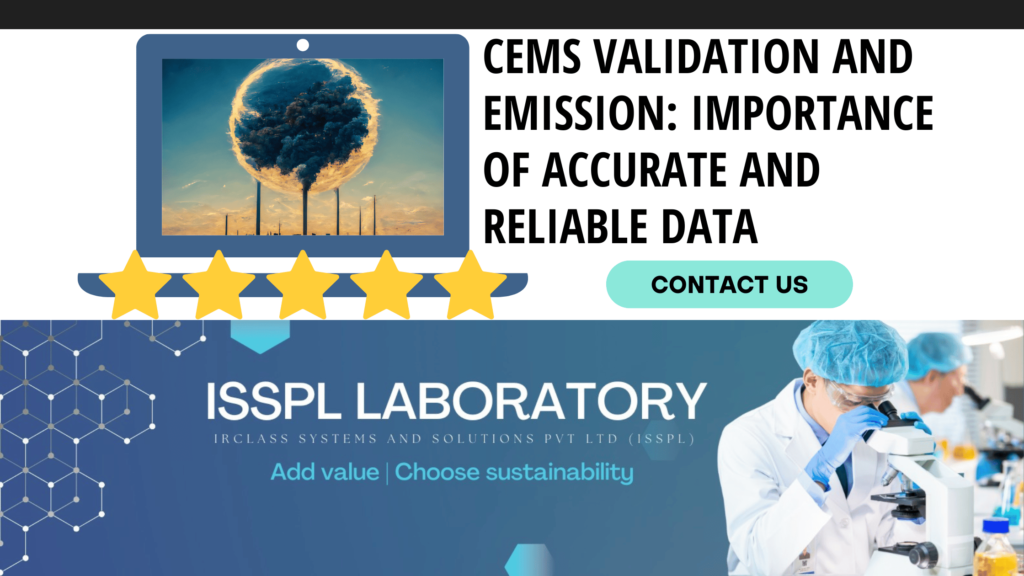An Overview by Team ISSPL - Analytical Testing Laboratory in India
ToggleContinuous Emission Monitoring Systems or CEMS is a process of reviewing the industrial discharges from the equipment pieces at industrial sites. It may be industrial refineries, oil and gas plants, or other facilities. It is a solution for new-age companies to follow complex regulations across the globe. The various regulations include Swiss OAPC, US EPE part 60/75, EN17255, KSA RCER and PME, Alberta CEMS code, and Canadian 1/EPS/PG7.
The essentiality of CEMS services
Monitoring emissions is a relevant topic, and it is related to the energy transition. It is an excellent and effective way to meet the requirements for climate change activism and government regulations. With the effective steps of CEMS services, one can recognize the impacts of the cost of CO2 emissions, allowances, and imposed taxes on CO2 emissions. For instance, the European Union is aiming to reduce the emission rate and percentage by 55% by the year 2030. The goal is to meet environmental regulatory compliance with several sources of industrial air pollutants. It is an indispensable step for avoiding hefty penalties and legal fines.
Why do you think the government is so concerned with it? Government regulations related to the limit of emissions make a difference in climate and global warming. On the one hand, the dense concentration of pollutants and air contaminants like CO2 creates a negative impact on the overall air quality levels in the vicinity of the industrial site. On the other hand, organic air contaminants like methane and carbon dioxide are impactful on the plant. Methane and carbon dioxide are collectively called greenhouse gases or GHGs. These harmful contaminants help trap the heat in the environment and increase the rate of global warming.
Choosing the apt CEMS application
How can you choose the appropriate products for Continuous Emission Monitoring System or CEMS application in the factory? How do you recognize the best technologies for your process? While reviewing and selecting the emission monitoring products, one may not stay sure about the ideal products. It is based on the requirements or process. The CEMS market is extensive, and there are various technologies and options. However, selecting the apt emission monitoring products depends on the specific process necessities.
CEMS is a critical step for all plants, refineries, power stations, and heavy-duty industrial sites. Simply put, it is vital for all industrial sites where the combustion of fuels is part of the process for different reasons. Firstly, it can offer end-to-end information about the levels of pollutants, dust, and concentrations of air contaminants like – SO2, NOx, CO, CO2, THC, and O2 at the site. It is essential to ensure safety for the workforce and anyone near the site including the environment. It must not pose a fire risk.
Site safety with CEMS – Besides the elementary purpose of enhancing site safety, CEMS offers extensive solutions. It also safeguards the facility with optimal compliance with legal obligations. It is a global concern, and there are numerous standards and techniques for environmental monitoring. All these are essential to monitor and analyze their gas flue effluents to ensure they comply with the relevant maximum thresholds for certain contaminants.
CEM and pollutant measurements
Continuous Emission Monitoring Systems are ideal for monitoring the concentrations of different pollutants, based on the industrial site necessities and regulations. The prime pollutants measured by CEMS include carbon monoxide or CO, carbon dioxide or CO2, sulfur dioxide or SO2, nitrogen oxides, hydrogen chloride or HCI, particulate matter, volatile organic compounds or VOC, ozone or O3, and heavy metals like mercury.
Mercury is toxic to the environment and is harmful to living beings including humans. Exposure to minimal amounts of Hg can have adverse health impacts. Mercury exposure to large amounts can be life-threatening and fatal. The prime sources of mercury emissions include –
- Mining industry
- Coal combustion
- Cement production
- Waste incineration
Identifying the apt system for CEM
It is necessary to pick the apt CEMS application for your company. It is critical to develop goals for environmental sustainability. The common reasons for choosing the ideal Continuous Emission Monitoring System in a company include the following –
- Enhance the environmental performance
- A proactive and liability-like approach to the environment
- Manage time and resources to effectively work on the ecological duties
- To gain a clarified overview of the environmental and business goals
- To comply with environmental norms and regulations
- To avoid the legal and hefty penalties.
- Support process control
- Enhance plant efficiency for the sustainability of the equipment
- Increase productivity at the site
- Decrease the operational and maintenance costs of the plant or industrial refinery
Industries that need CEM – Here’s a list of industrial domains that necessitate the ideal CEM –
- Power generation
- Waste incineration
- Oil and Gas
- Chemicals and petrochemicals
- Renewable Energy
- Pulp and paper
- Metals and minerals
- Landfills and biogas
- Marine
- Cement production, etc.
Key benefits of the CEM system
- Time and cost analysis – Time is a vital resource, and nothing less than money. An adequately utilized and well-implemented CEMS can reduce the time for monitoring effective emissions levels. The operators and technicians need to concentrate on other tasks.
- Maintenance – Nowadays, the Continuous Emission Monitoring System monitors proactively, and detects the existing operational issues via built-in tracking and calibration setup. One can find accurate reports. It is a critical function for cost-controlling, leading to a well-managed solution for time monitoring for the system.
- Reporting capabilities – A well-functioning Continuous Emission Monitoring System offers optimal clarity for reports. It transmits essential information over the TCP/IP network across the operational digital and analog channels. It helps you manage everything compactly, removing an additional step from the procedures, thereby saving time and money in the long run.
Testing and monitoring solutions – With the best lab
Get efficient solutions with the best-in-class lab facilities and ease the requirements. The accurate reports of Continuous Emission Monitoring Systems from IRCLASS Systems and Solutions Pvt Ltd or ISSPL laboratory can resolve the requirements for industrial testing with state-of-the-art analytical monitoring services.







